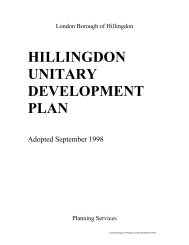Reluctant Gangsters - London Borough of Hillingdon
Reluctant Gangsters - London Borough of Hillingdon
Reluctant Gangsters - London Borough of Hillingdon
You also want an ePaper? Increase the reach of your titles
YUMPU automatically turns print PDFs into web optimized ePapers that Google loves.
Two quite distinct communities are emerging within the sector<br />
with quite pr<strong>of</strong>ound differences in lifestyles and culture. At<br />
one end there are the established elderly residents, who have<br />
lived in social housing all their lives and who remember a time<br />
when having a council home was a desirable goal. At the<br />
other end are the new, younger residents, frequently suffering<br />
from multiple problems: unemployment, poverty, poor work<br />
skills and perhaps mental illness and drug abuse as well.<br />
As a result, whereas at the beginning <strong>of</strong> the 1980s the average<br />
household income <strong>of</strong> council house residents was 73% <strong>of</strong> the<br />
national average, at the beginning <strong>of</strong> the 1990s this had fallen to<br />
48%. By 1995, over 50% <strong>of</strong> what had been council households had<br />
no breadwinner (Joseph Rowntree Foundation, 1995). By 1997,<br />
25% <strong>of</strong> the children and young people under 16 in the UK were<br />
living in these neighbourhoods.<br />
Waltham Forest is one <strong>of</strong> the most deprived <strong>London</strong> boroughs.<br />
Sixty-one <strong>of</strong> the borough’s ‘super output’ areas are amongst the<br />
most deprived 20% in England and Wales and 23 are in the top 5%.<br />
Unsurprisingly, most <strong>of</strong> these areas, located in Cathall, High Street,<br />
Leyton, Wood Street, Hoe Street, Leytonstone, Lea Bridge and<br />
Valley wards, have particularly high rates <strong>of</strong> crime in general and<br />
street crime and drug dealing in particular, and are home to the<br />
Waltham Forest gangs.<br />
Neighbourhood Destabilisation<br />
This income polarisation was mirrored in the housing market. The<br />
the Right to Buy and Tenant Incentive Schemes precipitated a<br />
‘secession <strong>of</strong> the successful’ as, increasingly, the economically<br />
active vacated what became known as ‘social housing’ to be<br />
replaced by the socially disadvantaged (Page 1993, Hope 1994). As<br />
Malcolm Dean (1997) observes:<br />
This happened despite the warnings <strong>of</strong> housing pr<strong>of</strong>essionals<br />
about the problems which public housing projects generated<br />
when they were confined to the poor, the unemployed and the<br />
elderly.<br />
This meant that many local authorities, including Waltham Forest,<br />
were left with the worst housing stock and the most needy tenants<br />
(KI.25, 32,33,34).<br />
In response, at the turn <strong>of</strong> the century, the housing authorities in<br />
Waltham Forest embarked upon an ambitious programme <strong>of</strong><br />
neighbourhood regeneration on some <strong>of</strong> the poorest housing estates<br />
in the borough. However, this ostensibly positive initiative had the<br />
15

















